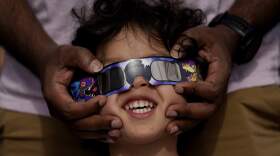A rare solar eclipse will be visible across North America this coming Monday afternoon. In central and northern Michigan, the eclipse peak will occur between 3:10 and 3:15 p.m.
North to south, from Sault Ste. Marie to Mount Pleasant, maximum coverage ranges from 83-93%. West to east, from Ludington to Harbor Beach, the range is from 89-95%. Only a sliver of Monroe County, south of Detroit, is in the path of totality.
WCMU's multi-media producer, Stefanie Mills spoke with Aaron Lacluze, an astronomer in the Department of Physics at Central Michigan University, to learn more about the science behind eclipses.
This transcript has been lightly edited for clarity and length.
Aaron Lacluze: We have two basic kinds of eclipses: solar and lunar eclipses. In both cases, it's really all about shadows. It's all about lining up the sun, the Earth and the moon.
With a lunar eclipse, the moon is passing through the shadow of the Earth, which has got a really big shadow. Lunar eclipses are relatively common, and they're pretty easy to see.
Solar eclipses, on the other hand, we've got the moon getting in the way of the sun, and so the moon's shadow is traveling across the Earth. Now, the moon's much smaller than the Earth, so its shadow is not as big. With a solar eclipse, you've got to be standing in just the right place, at just the right time to really see the most exciting part of the show.
What's exciting about this one is, it just so happens that, the sweet spot is here in the US.

Stefanie Mills: Yeah, absolutely, so talk about the path, where is it supposed to go?
AL: There's going to be a stripe that stretches from down in Mexico, up through Texas, southern Indiana, northern Ohio and then heads out to the East Coast.
In Michigan, unfortunately, we will not see totality, which is just south of us. And as much as it pains me to say such things, my best advice for my fellow Michiganders is go to Ohio.
Here in mid-Michigan, we will see a partial solar eclipse, so part of the sun will be blocked out by the moon, but not all of it. Totality is really just kind of a narrow stripe, and even in totality, you get kind of a small window for that.
From start to finish — the moment the moon starts to get in the way of the sun to when it goes fully away from the sun on the other side — that takes about 2-3 hours.
Totality, itself, only lasts a couple of minutes. The maximum it can possibly last is about seven and a half minutes for this particular eclipse. Given where the moon is and how much it's going to traverse the sun, we've got 3-4 minutes depending on where you are when it happens. So it is a very, very brief window.
It's really an odd experience. It's hard to describe unless you actually have experienced it.
SM: Because you actually went to see the last total eclipse. Can you share what that was like?
AL: I've been an astronomer for over 20 years. I'm in my mid-forties, and I had never seen a total solar eclipse with my own eyes [until recently]. Words are wholly inadequate to describe what it's like.
The moon starts to block out the sun, and the sun gets dimmer. We've all been outside on a summer day when a cloud passes in front of the sun, and the light levels just kind of drop real quickly.
It goes away after a few minutes, but when totality occurs, it kind of feels like you're wearing like a special pair of sunglasses that has a little dial on the side and someone is cranking it up and making it darker. But everything else looks normal — shadows are nice and sharp and distinct.

Unlike at sunset, when the sun goes down, shadows get really diffuse and long and then go away. That's a very gentle passage into nighttime, but with the eclipse, that's not what happens.
It gets really weird. I personally started to feel a little bit anxious, a little bit uneasy because the light's not right, for lack of a better word.
And then in every direction you looked, it looked like twilight. When the sun sets, you get that red or orange haze in the direction of where the sunset is. But the sun's up there and every direction looks like that because you're now in the shadow of the moon as it comes. So it was really, really strange.
We tend to think of the sun as just that disk on the sky, but it's not. There's more to the sun than that. Outside of the disk we see, which is called the photosphere in astronomy parlance, it's literally the sphere that the photons come from.
The photosphere is what our eyes normally see, and it's very bright. But once you cover it up, you can see the outer edges of the sun, a thing called the solar corona. It's this crown and weird, hazy thing around the edges of the sun.

You can think of it as the atmosphere of the sun. That's not quite right, but it's a good way to think about it. It's a very diffuse layer on the outside of the sun that you normally don't see with the naked eye because it's too faint. Once you block out that disk of the main sun, you can finally see it with your own eyes.
WCMU Public Television will air a half-hour special featuring Lacluze and the upcoming eclipse on Friday, April 5 at 7 p.m.
For more information on how the eclipse will touch down in your municipality, check out NASA's Eclipse Explorer map. Special eclipse glasses are strongly encouraged for viewers to prevent eye damage.







